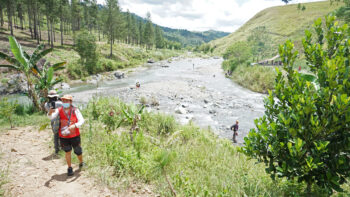In this very important and timely book – REVISITING DOCUMENTARY SOURCES IN MINDANAO MUSLIM HISTORY: From the Advent of Islam to the 1800s – a group of historians/social scientists of the Ateneo de Davao University (John Henry D. Gamas, Anderson V. Villa, Janor C. Balo, Mansoor L. Limba, Maria Janua P. Cunanan, Ramon B. Beleno III and Heidi K. Gloria) posit that “apart from material solutions, the Mindanao problem should also be addressed by acknowledging and rectifying its ideational causes as rooted in historical injustices.”
In order to make a contribution to this endeavor, they have edited, compiled and annotated mainly archival documents from various sources written across a number of centuries which, fortunately, have survived the travails of time and could be retrieved. By working diligently on this project, making sure to maintain a high level of scholarship, this group of historians have done Filipinos – and especially Mindanawons – a great favor. By bringing all these materials together in only one volume, they have made it easy for professors, students, researchers, civil servants, those in civil society organizations needing these data to access these, which are not easy to find these days. Not only are Filipinos benefitted but others who do research in this field. Finally, without having to spend hours searching for these materials, those interested can just refer to this book and find the information they need. In fact, this book now serves as a major contribution to the much needed literature for Mindanao Studies.
The compilation is most impressive, including the most important documents written about Muslim Mindanao’s history from way back the pre-conquest era (relying mainly on tarsilas which trace the Sultanates’ royal families’ genealogies) to those arising in the era of colonization written by chroniclers representing the Spanish crown as well as missionaries and even travellers who found their way to the fabled islands in this part of the planet. Going through the list of the original authors, translators as well as those who were the keepers of the documents the reader encounters the legendary names who have been associated with Moro history from the 1600s to 1990s: Leyden, Saleeby, Blair and Robertson, Laarhoven, Dampier, W.H. Scott, Majul, Mastura and the like.
We owe them a debt of gratitude for having committed to paper what needed to be written in those times as well as the book’s editors and compilers for now making it possible for us to have easy access to these documents. By presenting these primary source materials, the latter made it possible to integrate “Muslim historical experience to the discourse of Philippine history” and thus addressing a major “lacuna” in the manner that our country’s history is oftentimes projected and taught in schools which tends to privilege “one version of the struggle against Spanish colonization” that “glosses over parallel struggles across the archipelago.”
Even as this volume already includes what could be the more important documents, the editors/compilers “have no illusions… of presenting an exhaustive collection.” In fact, this book could serve as Volume I, and other volumes may have to be worked on that will then bring those written by more contemporary historians including Tan, Arcilla, Rodil, Abinales as well as Moro historians. They also warn the readers to be “circumspect while reading” these accounts, since most are written by Westerners with “crusading mindset,” manifesting “contempt for the people they regarded as culturally inferior.” In this sense, we need to heed what W. H. Scott proposed as being able to see through the “cracks in the parchment curtain,”
The residue of the historical injustices committed against the Moro people through time is the manner that most of the non-Moro segment of the nation’s population regard our Moro brothers and sisters. Strong prejudices and biases remain entrenched against the Moro people which have evolved into very condescending myths. Thus the labels: they are ignorant, lazy, manipulative, prone to violence, could not be trusted and lacking in grace and finesse. There is even the most objectionable adage – the only good Moro is the dead one!
Page after page, this book debunks all these myths. Because of Islam, a civilization arose among the Maguindanaos, Tausugs, Maranaws and Iranuns characterized by “a high literacy and love for learning.” Given their strategic location, they learned and spoke many languages. Considering the vast writing of tarsilas, there were scholars among them; albeit they were those of the ruling families. As in the books of James Warren, we are informed how trade flourished in Sulu and how Jolo became an important port linking the Jolo royal family with their counterparts in China and England and that this was possible given the Sultanate’s nautical technology and the level of its diplomacy. The Sultans did their best to enter into diplomatic relations with adjacent rulers and even with the Spanish colonizers. Its code of laws for its governance system – as embodied in the Magindanao Code of Laws (the luwaran, which include sections from classic Arabic laws) and the Principal Sulu Code – arose before the Katipunan’s cartilya and what came out of the short-lived 1898 Republic.
As one read through the texts, one is amazed to read the heroics and amazing deeds of mythological and historical figures whose names Mindanao Studies scholars encounter in their readings in history, anthropology and literature like those of Tabunaway, Indarapatra, Sulayman, Sharif Kabungsuwan, Sharif Maraja, Abu Bakr, Kudarat and so many more. On the colonizers’ end, the scholars encounter Legazpi, Dasmariňas, Figueroa, Corcuera as well as the Augustinian and Jesuit missionaries. There are names of places going back to the pre-conquest era that have survived through the years even as their spellings may have changed a bit; thus the names of Sulu, Basilan, Lamitan, Samboangan, Buayan, Palembang, Malabang and Butig.
If there is a Filipino who does not know why the Muslims in Mindanao are now called Moro, the book helps to explain why. It also provides the reader with an inkling as to why Spanish colonizers did their best to conquer the Moroland as they did the rest of the archipelago. Mindanao and Sulu were “strategically important to Spain both as a staging ground to the Moluccas and as a flank to secure the fledging Philippine colony.” But the accounts in this book show how the Sultanates which were “sophisticated and politically astute” could engage the colonizers at war as they had “carcoas and other indigenous warships” that “challenged Western gunboats by sheer maneuverability and speed.”
Because of their political and military strengths, the Sultanates managed to sustain a veritable resistance which the Spanish colonizers could not easily quell. It is in this context that one appreciates how Islam consolidated their ranks as it “became a unifying call against colonialism.” However my mid-19th century, the Moro resistance would begin to weaken leading ultimately to the displacement of the Moros from their territories. One of the factors for this decline of the Sultanates was “the introduction and use of steam gunboats” which were used “to combat piracy and curtail local trade.”
If there is a truism in the adage – “History is written by victors” (supposedly spoken by the likes of Winston Churchill and Walter Benjamin) – then this book once more affirms this saying. For the Moro people’s struggle for self-determination got stymied for both external (the force of colonization) and internal (power struggles among the ruling elites) reasons leading eventually to where the Moro people were as the 19th and 20th centuries dawned and how their situation is today. However, even as these accounts are biased from the “victors’ point of view” still, if one manages to see through the cracks of the parchment curtain, one cannot but be impressed how awesome the Sultanates’ power were in their heydays.
While this book is of primary importance to students of History, there are sections that should engage those in Anthropology. Of special interest would be the report written in 1779 by Captain Thomas Forrest, a trader who traveled through Mindanao who reported on “the thriving maritime trade network in Sulu which reached Java, Sumatra, the Moluccas and even as far as Ceylon Japan and China.” He was interested and thus wrote about languages and listing them down, thus indicating the various ethnolinguistic groups he encountered including: Illano (Iranun?), Magindanao, Dya, Manubo, Belam (B’laan?), Tagabaly (Tagabawa?), Kalagan, Eagubo (Manobo?), Mansaka, Matidrog (Matigsalug?), Bangil bangil, Matima Pulo, Matima Pute, Telandrig (Talaandig?) and Alang.
Theology and missiology students could also read sections that allow them to discover and critique missionary approaches during these times. The letter from Fr. Marcelo Francisco Mastrili, S.J. to the Provincial, Fr. Juan de Zalazar S.J. in 1637 is a detailed report on how the Spanish forces successfully conducted its war against the Moros led by Sultan Kudarat (also referred to in the text as Corralat) and how the missionaries played a role in this conquest. This letter provides a picture of how the Church operated in those years and the approaches that missionaries utilize to prosyletize. Churchpeople today can truly appreciate the big leap that the Church in Mindanao had taken since then, especially considering Vatican II theological and post-Vatican II missiological discourses.
A reader goes through this book and inevitably asks the question WHAT IF? What if Islam never reached the archipelago? What if the governance system of the Sultanates did not only arise in Sulu and Maguindanao but also parts of Luzon and the Visayas? What if it was the Portugese who colonized us rather than the Spanish? What if England managed to push Spain out of the archipelago and then took over the islands as it did other parts of Asia? What if Spain deteriorated further in the late 1700 and early 1800s and lost its hold on their Asian colony long before the rise of Filipino nationalism? What if the Mindanao Sultanates remained strong as the Americans sought to take over from Spain?
One can only conjecture the answers of these “What If” questions. But thanks to the publication of this book, we Filipinos need not spend too much time with the “What Ifs.” Instead we should focus on the “What were” and make sure all Filipinos of present and future generations – especially Mindanawons across the different ethnicities, cultural and faith traditions – are knowledgeable about the historical narratives compiled in this book.
To not take this into consideration would bring a curse for in the words of the poet-philosopher George Santayana (in The Life of Reason) – “those who do not learn history are doomed to repeat it” or “those who cannot remember the past are condemned to repeat it.” In fact, how can we even remember the past, if most of us have not heard or learned what the past in Mindanao was?
[Redemptorist Brother Karl Gaspar is Academic Dean of the Redemptorists’ St. Alphonsus Theological and Mission Institute (SATMI) in Davao City and a professor of Anthropology at the Ateneo de Davao University. Gaspar is author of several books, including “Desperately Seeking God’s Saving Action: Yolanda Survivors’ Hope Beyond Heartbreaking Lamentations” and two books on Davao history launched in December 2015. He writes two columns for MindaNews, one in English (A Sojourner’s Views) and the other in Binisaya (Panaw-Lantaw).]







